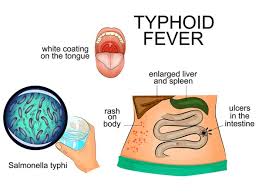Typhoid fever is a serious bacterial infection that easily spreads through contaminated water and food. Along with high fever, it can cause abdominal pains headache, and loss of appetite.
With treatment, most people make a full recovery. But untreated typhoid can lead to life-threatening complications.
What are the symptoms?
It can take a week or two after infection for symptoms to appear. Some of these symptoms are:
- high fever
- weakness
- stomach pain
- headache
- poor appetite
- rash
- Fatigue
- Confusion
- Constipation, diarrhea
Serious complications are rare, but can include intestinal bleeding or perforations in the intestine. This can lead to a life-threatening bloodstream infection (sepsis). Symptoms include nausea, vomiting, and severe abdominal pain.
Other complications are:
- pneumonia
- kidney or bladder infection
- pancreatitis
- myocarditis
- endocarditis
- Meningitis
- Delirium, hallucinations, paranoid psychosis
If you have any of these symptoms, tell your doctor about recent travels outside the country. 
What are the causes and risk factors?
Typhoid is caused by bacteria called Salmonella typhi (S. typhi). It’s not the same bacterium that causes the foodborne illness Salmonella.Its main method of transmission is the oral-fecal route, generally spreading in contaminated water or food. It can also be passed through direct contact with an infected person.
In addition, there are a small number of people who recover but still carry S. typhi. These “carriers” can infect others.
Some regions have a higher incidence of typhoid. These include Africa, India, South America, and Southeast Asia.
Worldwide, typhoid fever affects more than 26 million people per year. The United States has about 300 cases per year.
Can it be prevented?
When traveling to countries that have higher incidences of typhoid, it pays to follow these prevention tips:
Be careful about what you drink
- don’t drink from the tap or a well
- avoid ice cubes, popsicles, or fountain drinks unless you’re certain they’re made from bottled or boiled water
- buy bottled drinks whenever possible (carbonated water is safer than non-carbonated, be sure bottles are tightly sealed)
- Non-bottled water should be boiled for one minute before drinking
- It’s safe to drink pasteurized milk, hot tea, and hot coffee
- Watch what you eat
- don’t eat raw produce unless you can peel it yourself after washing your hands
- never eat food from street vendors
- don’t eat raw or rare meat or fish, foods should be thoroughly cooked and still hot when served
- Eat only pasteurized dairy products and hard-cooked eggs
- avoid salads and condiments made from fresh ingredients
- don’t eat wild game
- Practice good hygiene
- wash your hands often, especially after using the bathroom and before touching food (use lots of soap and water if available, if not, use hand sanitizer containing at least 60 percent alcohol)
- don’t touch your face unless you’ve just washed your hands
- Avoid direct contact with people who are sick
if you’re sick, avoid other people, wash your hands often, and don’t prepare or serve food
What about a typhoid vaccine?
For most healthy people, the typhoid vaccine is not necessary. But your doctor might recommend one if you’re:
- a carrier
- In close contact with a carrier
- traveling to a country where typhoid is common
- a laboratory worker who may come in contact with S. typhi
The typhoid vaccine is 50 to 80 percent effective and comes in two forms:
Inactivated typhoid vaccine. This vaccine is a one-dose injection. It’s not for children younger than two years old and it takes about two weeks to work. You can have a booster dose every two years.
Live typhoid vaccine. This vaccine is not for children under age six. It’s an oral vaccine given in four doses, two days apart. It takes at least a week after the last dose to work.
What’s the outlook?
Without treatment, typhoid can lead to serious, life-threatening complications.






